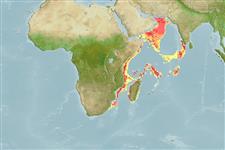Classification / Names
आम नाम | उपशब्द | Catalog of Fishes(वर्ग, प्रजाति) | ITIS | CoL | WoRMS | Cloffa
इलाज़मौबरांकी (शारक और रेज़) (sharks and rays) >
Carcharhiniformes (Ground sharks) >
Pentanchidae (Deepwater catsharks)
Etymology: Bythaelurus: bythos (Gr.), depths of the sea, referring to its deepwater habitat; ailouros (Gr.), cat, probably an allusion to the vernacular “catshark,” so named for its cat-like eyes (See ETYFish); tenuicephalus: tenuis (L.), slender; cephalus, from kephale (Gr.), head, referring to its “remarkably” narrow head and snout (See ETYFish).
Environment: milieu / climate zone / depth range / distribution range
पारिस्थितिकी
समुद्री; गहराई सीमा 463 - 550 m (Ref. 106604). Tropical
वितरण
देश | ऐफ ऐ ओ क्षेत्र | Ecosystems | संयोग | Point map | भूमिका | Faunafri
Western Indian Ocean: off Tanzania and Mozambique.
आकार / वज़न / Age
Maturity: Lm ? range ? - ? cm
Max length : 300 cm TL पुल्लिंग / अलिंग; (Ref. 106604)
Short description
पहचान कुंजी | आकृति विज्ञान | मौरफोमैटरिक्स
This species is distinguished from its congeners by the following characters: slender head and snout, only slightly bell-shaped in dorsoventral view without distinct lateral indention (vs. distinctly bell-shaped snouts with a strong lateral indention anterior to outer nostrils); has broader claspers in adult males, the base width 2.1% TL (vs. 1.51.8% TL of congeners in the western Indian Ocean); further differs from B. clevai by having a smaller maximum size and a color pattern of fewer and smaller blotches, larger oral papillae, a shorter snout, and broader claspers without knob-like apex and with a smaller envelope and a subtriangular (vs. subrectangular) exorhipidion; differs from B. hispidus by having a longer snout, a longer dorsal-caudal space, broader clasper without knob-like apex, and fewer vertebral centra; differs from B. lutarius by having a smaller maximum size and has a blotched (vs. largely plain) coloration, numerous (vs. lacking) oral papillae, shorter anterior nasal flaps, a longer caudal fin, a shorter pelvic anal space, and shorter and broader claspers (Ref. 104913).
Life cycle and mating behavior
परिपक्व अवधि | पुनरुत्पत्ति | मछलीऔ का अंडे देना | अंडे | Fecundity | लार्वा
Kaschner, C.J., S. Weigmann and R. Thiel, 2015. Bythaelurus tenuicephalus n. sp., a new deep-water catshark (Carcharhiniformes, Scyliorhinidae) from the western Indian Ocean. Zootaxa 4013(1):120-138. (Ref. 104913)
IUCN Red List Status (Ref. 130435: Version 2024-1)
Threat to humans
Harmless
Human uses
साधन
Special reports
Download XML
इंटरनेट स्रोत
Estimates based on models
Phylogenetic diversity index (Ref.
82804): PD
50 = 0.5001 [Uniqueness, from 0.5 = low to 2.0 = high].
Bayesian length-weight: a=0.01000 (0.00244 - 0.04107), b=3.04 (2.81 - 3.27), in cm total length, based on all LWR estimates for this body shape (Ref.
93245).
Trophic level (Ref.
69278): 5.0 ±0.5 se; based on size and trophs of closest relatives
लौटाव (Ref.
120179): बहुत नीचे, न्यूनतम जनसंख्या दुगनी समय अवलागत 14 महीने। (Preliminary K or Fecundity.).
Fishing Vulnerability (Ref.
59153): Very high vulnerability (90 of 100).
